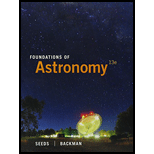
Concept explainers
The lifetime of main-sequences of Star A compared to the sun.
The lifetime of main-sequences of Star B compared to the sun.
The luminous of main-sequences of Star A compared to the sun.
The luminous of main-sequences of Star B compared to the sun.
Answer to Problem 6P
The lifetime of main-sequences of Star A compared to the sun is
The lifetime of main-sequences of Star B compared to the sun is
The luminous of main-sequences of Star A is
The luminous of main-sequences of Star B is
Explanation of Solution
Write the expression for the stellar life expectancies of star A.
Here,
Rewrite the above expression for luminosity of star A.
Here,
Write the expression for the stellar life expectancies of star B.
Here,
Rewrite the above expression for luminosity of star B.
Here,
Conclusion:
Substitute
Substitute
Substitute
Substitute
Therefore, the lifetime of main-sequences of Star A compared to the sun is
Want to see more full solutions like this?
Chapter 12 Solutions
Foundations Of Astronomy, Loose-leaf Version
- If you were to compare three stars with the same surface temperature, with one star being a giant, another a supergiant, and the third a main-sequence star, how would their radii compare to one another?arrow_forwardAre supergiant stars also extremely massive? Explain the reasoning behind your answer.arrow_forwardA G2 star has a luminosity 100 times that of the Sun. What kind of star is it? How does its radius compare with that of the Sun?arrow_forward
- According to the text, a star must be hotter than about 25,000 K to produce an H II region. Both the hottest white dwarfs and main-sequence O stars have temperatures hotter than 25,000 K. Which type of star can ionize more hydrogen? Why?arrow_forwardWe will take a moment to compare how brightly a white dwarf star shines compared to a red giant star. For the sake of this problem, let's assume a white dwarf has a temperature around 10,000 K and a red giant has a temperature around 5,000 K. As for their stellar radiatin, the white dwarf has a radius about 1/100th that of the Sun, and a red giant has a radius around 100 times larger than the Sun. With this in mind, how does the luminosity of a red giant star compare to that of a white dwarf (Hint: do not try to enter all of these numbers into the luminosity equation {it won't go well}; instead, remember that you are only interested in the ratio between the two, so all common units and components can be divided out)? Please enter your answer in terms of the luminosity of the red giant divided by the luminosity of the white dwarf and round to two significant figures. Also, please avoid using commas in your answer.arrow_forwardA star with spectral type A0 has a surface temperature of 9600 K and a radius of 2.2 RSun. How many times more luminous is this star than the Sun? (if it is less luminous enter a number less than one) This star has a mass of 3.3 MSun. Using the simple approximation that we made in class, what is the main sequence lifetime of this star? You may assume that the lifetime of the sun is 1010 yr. Compare this to the lifetime of a A0 star listed in Table 22.1 (computed using a more sophisticated approach). Is the value you calculated in the previous problem longer or shorter than what is reported in the table? (L for longer, S for shorter) (You only get one try at this problem.)arrow_forward
 Foundations of Astronomy (MindTap Course List)PhysicsISBN:9781337399920Author:Michael A. Seeds, Dana BackmanPublisher:Cengage Learning
Foundations of Astronomy (MindTap Course List)PhysicsISBN:9781337399920Author:Michael A. Seeds, Dana BackmanPublisher:Cengage Learning Stars and Galaxies (MindTap Course List)PhysicsISBN:9781337399944Author:Michael A. SeedsPublisher:Cengage Learning
Stars and Galaxies (MindTap Course List)PhysicsISBN:9781337399944Author:Michael A. SeedsPublisher:Cengage Learning AstronomyPhysicsISBN:9781938168284Author:Andrew Fraknoi; David Morrison; Sidney C. WolffPublisher:OpenStax
AstronomyPhysicsISBN:9781938168284Author:Andrew Fraknoi; David Morrison; Sidney C. WolffPublisher:OpenStax
 Stars and GalaxiesPhysicsISBN:9781305120785Author:Michael A. Seeds, Dana BackmanPublisher:Cengage Learning
Stars and GalaxiesPhysicsISBN:9781305120785Author:Michael A. Seeds, Dana BackmanPublisher:Cengage Learning




